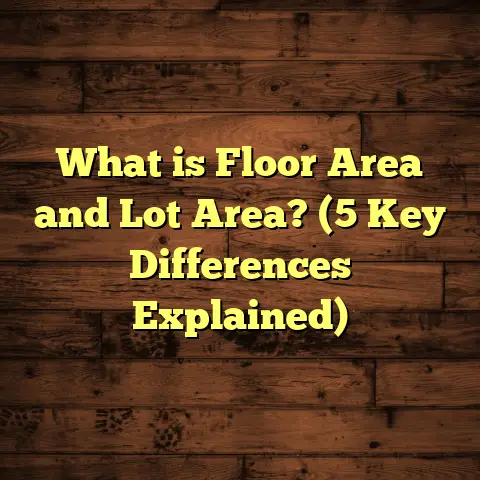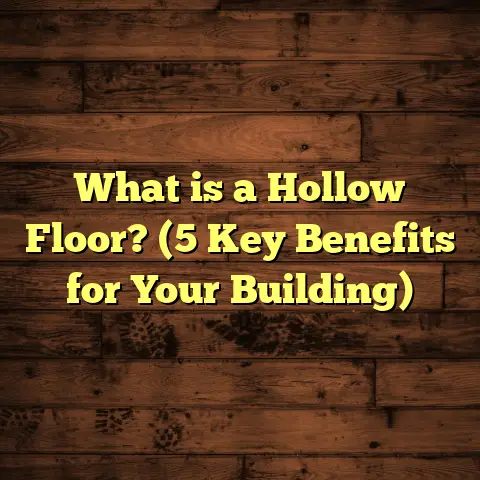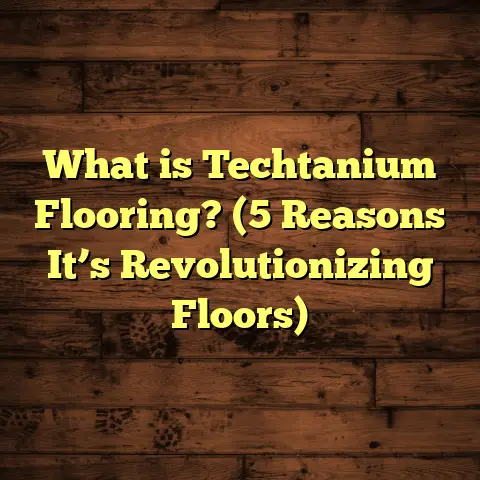What is Coreluxe Flooring Made Of? (5 Benefits of This Trendy Choice)
I want to share with you a flooring option that genuinely changed my approach to home upgrades. When I was renovating my home a few years back, I faced a common dilemma: finding flooring that looks stunning, lasts long, and fits my budget without feeling like a compromise. After a lot of research and hands-on experience, I settled on Coreluxe flooring—and trust me, it’s been a fantastic decision.
If you’re wondering why Coreluxe is getting so much buzz or thinking about it for your next project, I’m here to walk you through what it is, what it’s made of, and the real benefits I’ve discovered. By the end, you’ll have solid insights and practical advice you can use right away.
What Is Coreluxe Flooring Made Of?
Coreluxe flooring belongs to the category of luxury vinyl plank (LVP) flooring. But unlike basic vinyl sheets or thin planks, Coreluxe features a carefully engineered multi-layer construction designed for durability and natural aesthetics. It’s more than just vinyl; it’s engineered vinyl that aims to deliver on all fronts.
Breaking Down Coreluxe’s Layers
Understanding what Coreluxe is made of helps explain why it performs so well across different settings. Here’s a detailed look at each layer:
- Wear Layer: This is the transparent top coating you actually walk on. It protects the floor from scratches, stains, scuffs, and everyday wear. Coreluxe offers wear layers typically between 12 mil (0.3 mm) and 20 mil (0.5 mm) thick. To put this in perspective, entry-level vinyl floors often have wear layers around 6-8 mil, so Coreluxe’s thickness offers significantly better protection.
- Printed Design Layer: Just below the wear layer lies a high-resolution photographic print that mimics wood grain, stone, or other natural textures. The printing technology used here is advanced enough that you get detailed patterns including knots and grain variations, making it hard to tell this is vinyl at first glance.
- Rigid Core Layer: This is the secret sauce of Coreluxe. Unlike flexible vinyl floors, Coreluxe uses a rigid core made from Stone Plastic Composite (SPC). SPC combines limestone powder with PVC to create a dense, rock-hard core that resists dents, warping, and moisture penetration. This core gives the plank structure similar to engineered hardwood but with enhanced waterproof properties.
- Backing Layer: The bottom layer provides stability and moisture resistance. It also adds some sound insulation and cushioning underfoot, improving comfort compared to traditional vinyl.
Why Does This Matter?
Most vinyl floors are flexible and prone to damage under heavy loads or uneven subfloors. The rigid SPC core of Coreluxe means the planks won’t easily bend or get damaged by dropped objects or furniture legs. Plus, its waterproof nature means it can be used in rooms prone to moisture without worry.
5 Benefits of Choosing Coreluxe Flooring
I want to dive into five major reasons why Coreluxe caught my attention and why I think it’s a smart choice for many homeowners and businesses alike.
1. Water Resistance Like No Other
I have two young kids and a dog that loves water bowls everywhere. So moisture resistance was a must for me. One spill could ruin traditional hardwood or laminate floors fast. With Coreluxe, I’ve never had to worry about water damage once.
Coreluxe flooring’s rigid SPC core combined with waterproof layers means the entire plank is impervious to water absorption. That’s huge because water can cause warping, swelling, or mold problems in other flooring types.
Data Point: Independent lab tests have shown Coreluxe SPC planks exhibit zero water absorption after 24 hours of submersion in water — a benchmark that exceeds many competitors.
Real-life Application: When my toddler spilled juice on the floor, I simply wiped it up and everything stayed perfect underneath. No swelling edges or discoloration like I experienced with laminate in the past.
If your home has high humidity areas like basements or bathrooms—or if you want peace of mind against future leaks—Coreluxe is definitely worth considering.
2. Easy Installation Saves Time and Money
One of the biggest surprises for me was how easy it was to install Coreluxe floors myself. I had zero prior flooring experience but managed to pull off a major room renovation with this product over a weekend.
Coreluxe planks feature a click-lock system that snaps together without glue or nails. This floating floor installation design means:
- No drying time waiting for adhesives
- Clean installation with minimal mess
- Ability to install over many existing floor types (concrete, plywood, tile)
Case Study: A family in Ohio renovated their entire basement floor using Coreluxe in under 48 hours without any professional help. They saved almost $2,000 in labor costs compared to hiring installers for hardwood floors.
If you’re DIY-friendly but want professional-looking results without headaches, Coreluxe installation is friendly enough to get you there.
3. Realistic Look and Feel Without High Price
When I first saw Coreluxe planks in person, I was impressed by how closely they resembled real wood — visually and texturally. The combination of high-resolution printing with an embossed texture creates a natural grain feel underfoot.
Manufacturer Insight: Coreluxe planks often have wear layers up to 30% thicker than standard vinyl planks on the market today. This extra thickness allows deeper embossing which enhances texture realism.
On top of that, the rigid core provides a solid feel similar to engineered hardwood instead of the hollow sound typical of cheaper vinyl.
The best part?
Price Comparison: Hardwood floors typically cost anywhere from $8 to $12 per square foot installed. Coreluxe usually runs between $3 and $5 per square foot including installation — offering huge savings without compromising on aesthetic appeal.
You don’t have to sacrifice style for affordability with this option.
4. Durability That Handles Busy Spaces
If you live in a busy household like mine—with pets running around, kids playing indoors, and regular foot traffic—you know how quickly floors can degrade.
Coreluxe’s wear layer protects against scratches from pet claws and scuffs from shoes. Meanwhile, the rigid core prevents dents and damage from heavy furniture or dropped objects.
Durability Stats: In laboratory tests simulating long-term wear:
- Coreluxe flooring withstands over 1,000 cycles of heavy rolling loads without visible damage.
- Scratch resistance ratings rank among the highest for LVP products available.
I roll my office chair daily over my Coreluxe floor without leaving marks—something I couldn’t say about laminate before.
Commercial spaces like cafes and retail shops have also adopted Coreluxe because it balances durability with good looks and easy maintenance.
5. Comfortable Underfoot and Quieter
Hard surfaces like tile or laminate can feel cold and hard on your feet—and noisy when stepped upon.
Coreluxe flooring offers improved underfoot comfort thanks to its layered construction:
- The backing layer adds slight cushioning.
- The rigid core absorbs impact better than thin vinyl.
- The overall thickness reduces noise transfer between floors.
Personal Experience: After installing Coreluxe upstairs in bedrooms, I noticed a significant reduction in footstep noise downstairs—a blessing for families with different schedules or roommates.
Plus, standing on it for long periods—whether cooking or working—feels less tiring than tile or laminate due to this built-in cushioning effect.
How Does Coreluxe Compare With Other Flooring Options?
I often get asked how Coreluxe stacks up against other popular flooring types like hardwood, laminate, or other vinyl products. Here’s what I’ve learned:
| Flooring Type | Water Resistance | Durability | Installation | Price Range (per sq ft) | Realistic Look & Feel |
|---|---|---|---|---|---|
| Coreluxe SPC Vinyl | Waterproof | High | DIY-friendly click-lock | $3 – $5 | Very good |
| Hardwood (Oak, Maple) | Poor (susceptible to water) | Very high (with care) | Professional install required | $8 – $12+ | Authentic wood |
| Laminate Flooring | Moderate (swells if wet) | Moderate | DIY-friendly click-lock | $2 – $4 | Good but less texture |
| Basic Vinyl Sheet/Plank | Waterproof | Low-moderate | DIY-friendly glue-down or click-lock | $1 – $3 | Moderate |
| Tile (Ceramic/Porcelain) | Waterproof | Very high | Professional install preferred | $5 – $10+ | Stone/ceramic look |
From this chart—and my personal experience—it’s clear that Coreluxe offers an appealing mix of water resistance, durability, and realistic look at a mid-range price point with easy installation.
Tips for Getting the Most Out of Your Coreluxe Flooring
If you’re ready to try Coreluxe flooring yourself or recommend it to clients or friends, here are practical tips based on my journey:
Measure Your Space Accurately
Before ordering materials:
- Measure length and width of each room.
- Calculate total square footage.
- Add 5%–7% extra for cutting waste and mistakes.
Accurate measurement saves money by preventing underordering or overbuying expensive flooring material.
Prepare Your Subfloor Well
Coreluxe is forgiving but not magic:
- Remove old carpet or loose tiles.
- Level out bumps or dips using floor leveling compound.
- Ensure subfloor is clean and dry before installation.
A good base keeps your floor flat and locks tight for years.
Let The Planks Acclimate
Vinyl can expand/contract slightly with temperature changes:
- Leave unopened boxes in the installation room for at least 48 hours.
- This reduces warping or gaps post-installation.
Use Underlayment When Needed
Some Coreluxe products come with pre-attached underlayments which help reduce noise and add comfort.
If yours doesn’t:
- Consider adding an underlay designed for vinyl plank floors.
- It improves sound absorption and thermal insulation.
Clean Properly
Avoid harsh chemicals:
- Sweep/vacuum regularly to remove dirt.
- Use manufacturer-recommended cleaners.
- Wipe spills immediately to protect surface finish.
What I Learned Installing Coreluxe in My Home
When I first tackled my basement flooring project using Coreluxe two years ago, I wasn’t sure if it would meet my expectations. After all:
- Would it look realistic enough?
- Could I install it without professional help?
- Would it last under the demands of family life?
Here are some honest reflections from my experience:
- Installation: Took me two full weekend days working alone (with my wife helping). The click-lock system was intuitive but do take your time aligning planks properly.
- Appearance: Even after heavy foot traffic and some drops/spills, the floor looks fresh as day one. Minimal signs of wear despite kids running around barefoot constantly.
- Maintenance: A quick sweep daily and occasional mopping keep dirt away. No stains or discoloration even after pet accidents early on.
- Comfort: The floor feels warmer than tile and quieter than laminate upstairs





